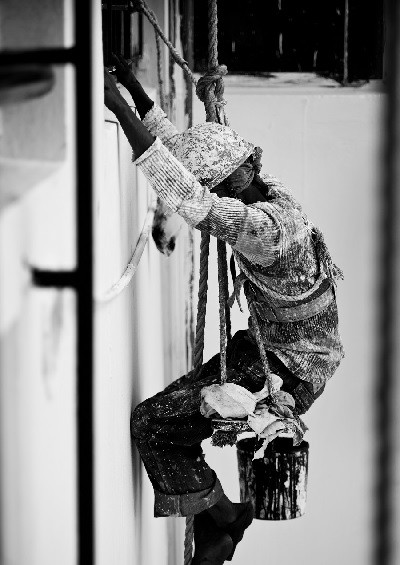Moving with the Market in India
An man from the slums of India makes his living by doing the dangerous work of painting high-rise towers in Kolkata.

Credit: Dripta Guha Roy/The Other Hundred
Dripta Guha Roy was born in Kolkata, India, but then moved abroad at the age of two. He grew up in Canada, the Netherlands and Singapore. He studied at McGill University in Canada and Eindhoven University of Technology in Netherlands. For the past six years, he has run his own design studio in London, while also working as a photographer covering events such as the London Olympics, the ColorRun and The Holi Festival in London.
Avid Kumar runs a four-person business painting the exteriors of high-rise towers in Kolkata, the capital of India’s West Bengal state. Painting a building typically earns him around 10,000 rupees (US$160), far more than he could earn by taking on many smaller projects. Even so, he cannot afford proper safety equipment for himself and his team.
Avid was born in Kolkata after his parents moved there from Bihar state, West Bengal’s western neighbor. He was raised and still lives in one of the city’s many slum districts. His first job was carrying live chickens to a market on a bicycle.
But as the rising popularity of Western-style supermarkets cut demand at the market, he switched to painting when he was 19. Although he relies on his personal connections with staff at the huge property companies that manage the blocks, his biggest worry is getting paid on time.
Text and photographs by Dripta Guha Roy

Dripta Guha Roy was born in Kolkata, India, but then moved abroad at the age of two. He grew up in Canada, the Netherlands and Singapore. He studied at McGill University in Canada and Eindhoven University of Technology in Netherlands. For the past six years, he has run his own design studio in London, while also working as a photographer covering events such as the London Olympics, the ColorRun and The Holi Festival in London.
The Other Hundred is a unique photo-book project aimed telling the stories of people around the world who are not rich but who deserve to be celebrated.
The Other Hundred Entrepreneurs: 100 Faces, Places, Stories — the second volume in The Other Hundred series — focuses on the world’s everyday entrepreneurs. It captures the reality that small and medium-sized businesses, rather than tech billionaires or elite MBAs, contribute the majority of the world’s jobs, including half of all jobs in Africa and two-thirds in Asia.
The book offers an alternative to the view that most successful entrepreneurs were trained at elite business schools. Here are people who have never written a formal business plan, hired an investment bank, planned an exit strategy or dreamt of a stock market floatation. Some work for themselves, others employ a few people, still others a few hundred.
 The book’s 100 stories were chosen from a pool of 10,000 images shot in nearly 150 countries. The book is published by Oneworld Publications in London and is available in bookstores worldwide and online.
The book’s 100 stories were chosen from a pool of 10,000 images shot in nearly 150 countries. The book is published by Oneworld Publications in London and is available in bookstores worldwide and online.





























